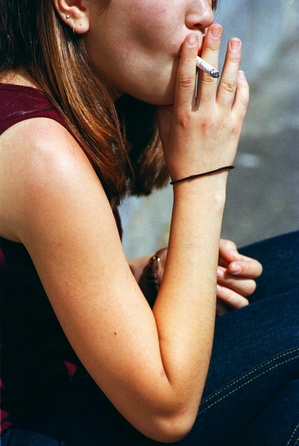Editor's note: This story has been edited with the correct spelling of Bruce Thomson's name.
Though eighth grade students appear to be making greater strides in smoking less than their older counterparts, an annual study has revealed that amongst high school seniors, binge drinking and misuse of Adderall is becoming more prevalent.
Overall, the number of U.S. teenagers smoking is continuing to drop and the number of teens using marijuana has not increased for the first time in four years, according to an annual Monitoring the Future report released Wednesday morning.
The report is the result of a national study of 45,000 to 50,000 students in eighth, tenth and twelfth grades that is designed and conducted by researchers at the University of Michigan.
About 24 percent of the high school seniors surveyed reported binge drinking within the past two weeks in 2012 - an increase of two percent from 2011. For the purpose of the study, binge drinking was defined as having more than five drinks in a row.
Clik here to view.

The percentage of U.S. teens that smoke has continued to decline in 2012, according to an annual report released Wednesday.
AP File photo
Bruce Thomson is a psychotherapist with private practice in Ann Arbor who does interventions and recovery coaching for drug addicts. Additionally, he lectures in Michigan high school on addiction, for the University of Michigan and the National Association of Social Workers.
Adderall is “prevalent” amongst high school students, Thomson said, and many use it to concentrate to study for tests. Misuse increases in college students, Thomson said.
Often, many teens don’t consider Adderall to be an illicit drug, Thomson said.
“If you need (Adderall), then it is absolutely a wonderful thing: It can help you study, help you focus. It really can be life altering in a very good way,” he said. “The downside is, if you don’t need it, then you’re just taking Speed - a stimulant. There’s a deeper level question of what is the psychology of taking a drug you don’t really need.”
Side affects could contribute to high blood pressure and heart complications - including heart attacks at the extreme end, Thomson said. Mixing Adderall with other medications could have other negative affects and reinforces the need for the drug to be administered under the supervision and guidance of a doctor.
In 2010, the Monitoring the Future report indicated that the continuous decline in teen smoking rates year after year might have stabilized. Throughout 2011 and 2012, teen smoking rates have continued to drop, which the study links to an increase to the federal tax on tobacco products that took effect in 2009.
The biggest difference in smoking habits appears amongst eighth grade students, as the study found a drop amongst students that have reported using cigarettes in the past 30 days from 6.1 percent to 4.9 percent between 2011 and 2012. For students in tenth and twelfth grades, that figure has dropped a percentage point to 10.8 percent and 17.1 percent, respectively.
In 1996 when teen smoking rates were at their peak, 49 percent of eighth grade students had tried cigarettes. In 2012, that proportion is 16 percent, according to the study.
Clik here to view.

Lloyd Johnston
Courtesy U-M
Smoking has become more prevalent in high schools than in middle schools because of the increased reinforcement amongst younger students between the ages of 12 and 13 years old about the negative affects of smoking, Thomson said.
When it comes to older teens, they’re drawn to smoking because of the rebellious association of doing something “bad,” Thomson said.
“It’s not based on logic at that point; it’s based on the draw of the ‘bad’ activity,” Thomson said. “The primary driver for use of something like (cigarettes) is social inclusion.”
Teenagers’ disapproval of smoking is at an all-time high for all three grades surveyed: 89 percent of eighth graders disapproved of smoking, while 84 percent of twelfth graders did not approve of the habit.
The use of hookah water pipes to smoke flavored tobacco and small cigar use have remained constant amongst twelfth grade students surveyed from 2010 to 2012 at 18 percent and 20 percent, respectively.
For the past four years, marijuana use - and especially daily marijuana use - had been rising amongst teens. In 2012, researchers saw use rates stabilize for the first time.
"Whether this is more than a pause in the ongoing increase that we have seen in teen marijuana use in recent years is unclear at this point," Johnston said. "One important variable that has been a lead indicator of use - namely the amount of risk teenagers perceived to be associated with marijuana us - continued its sharp decline in 2012 among teens, which would suggest further increases in use in the future."
The prevalence of marijuana use in 2012 was highest amongst older teens:
- Eighth grade: 11 percent
- Tenth grade: 28 percent
- Twelfth grade: 36 percent
Lecturing around the state in various high schools on drug addiction, Thomson said every class he speaks to says the drug of choice is marijuana.
One in 15 high school seniors is a daily or near-daily marijuana user, according to the report.
However, Thomson said he believes alcohol use amongst teens outweighs marijuana use, but teens choose not to identify it as a “drug.”
“Alcohol is taken so casually,” Thomson said. “It doesn’t get the attention that marijuana does with paraphernalia and laws and possession charges.”
Compared to alcohol, marijuana is expensive. Additionally, the marijuana in circulation now is eight to 10 times more potent than the marijuana that was popular in the 1960s, Thomson said.
“It’s a far more potent chemical,” Thomson said of the marijuana in circulation now. “We’re seeing more impact from those that are steady or serious smokers We see withdrawal from heavy users.”
Eighth grade students saw the biggest decline in marijuana usage rates from 13.7 percent in 2010 to 11.4 percent in 2012.
About half of America's high school seniors have tried an illicit drug - typically marijuana - by the time they graduate and four fifths of them have used it in within the past year, according to the study.
The study also reported that use of Ecstasy, salvia and heroin without a needle amongst teens have significantly declined between 2011 and 2012.
Amy Biolchini covers Washtenaw County, health and environmental issues for AnnArbor.com. Reach her at (734) 623-2552, amybiolchini@annarbor.com or on Twitter.